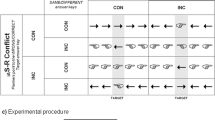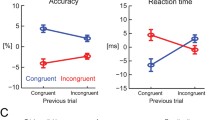Summary
Eleven subjects were tested with a modified version of Eriksen's noise-compatibility task. Four noise conditions were realized - neutral, compatible, fully incompatible, and partially incompatible context. Target and flanking stimuli had an intrinsic association to either the left- or the right-hand side. As a response subjects pulled, with either their left or their right hand, an ordinary bicycle handbrake from a preload position towards a stop. The EMG from the forearm muscles and the movement trajectory were recorded continuously. Trials were categorized according to the outcome states, i. e., whether a full movement or only a rudimentary EMG activation had occurred in the correct and in the incorrect response channels, respectively, and whether the correct-channel activation was leading or lagging.
Incompatible noise delayed information transfer and increased the likelihood of errors, while compatible noise had an opposite effect, i. e., it facilitated transfer and reduced the likelihood of errors. The effect of noise on transfer times was the same for all outcome states. Moreover, in all cases, noise had an effect on transfer times only up to the point of EMG onset, while it left movement-execution times unaffected. These findings are seen as contradictory to a strong continuous flow conception according to which any response-related change in the input channel is continuously and immediately transferred to the response-execution device. At least the final stage of movement control seems to be autonomous and not subject to input control, except for the case that a movement already initiated has to be aborted completely.
Similar content being viewed by others
References
Coles, M. G. H. (1989). Modern mind-brain reading: Psychophysiology, Physiology, and Cognition. Psychophysiology, 26, 251–269.
Coles, M. G. H., Gratton, G., Bashore, T. R., Eriksen, C. W., & Donchin, E. (1985). A psychophysiological investigation of the continuous flow model of human information processing. Journal of Experimental Psychology: Human Perception and Performance, 11, 529–553.
de Jong, R., Coles, M. G. H., Logan, G., & Gratton, G. (1990). In search of the point of no return: The control of response processes in speeded choice reaction performance. Journal of Experimental Psychology: Human Perception and Performance, 16, 164–182.
Donchin, E. (1984). Cognitive psychophysiology. Hillsdale, NJ: Erlbaum.
Eriksen, C. W., & Eriksen, C. W. (1974). Effects of noise letters upon the identification of a target letter within the display impair processing. Perception & Psychophysics, 16, 143–149.
Eriksen, C. W., & Schultz, D. W. (1979). Information processing in visual search: a continuous flow conception and experimental results. Perception & Psychophysics, 25, 249–263.
Falkenstein, M., Hohnsbein, J., Hoormann, J., & Blanke, L. (1991) Effects of crossmodal divided attention on late ERP components: II. Error processing in choice reaction tasks. Electroencephalography and Clinical Neurophysiology, 78, 447–455.
Gratton, G., Coles, M. G. H., Sirevaag, E. J., Eriksen, C. W., & Donchin, E. (1988). Pre- and poststimulus activation of response channels: A psychophysiological analysis. Journal of Experimental Psychology: Human Perception and Performance, 14, 331–344.
Grice, G. R., Nullmeyer, R., & Spiker, V. A. (1982). Human reaction time: Toward a general theory. Journal of Experimental Psychology: General, 111, 135–153.
Huynh, H., & Feldt, L. S. (1976). Estimation of the box correction for degrees of freedom from sample data in randomized block and splitplob designs. Journal of Education Statistics, 1, 69–82.
Luce, R. D. (1986). Response Times: Their Role in Inferring Elementary Mental Organization (Oxford Psychology Series; No. 8). Oxford: Oxford University Press.
McCarthy, G., & Donchin, E. (1983). Chronometric analysis of human information processing. In A. W. K. Gaillard & W. Ritter (Eds.), Tutorials in ERP research: Endogenous components pp. 251–268. Amsterdam: North-Holland.
McClelland, J. L. (1979). On the time relations of mental processes: An examination of systems of processes in cascades. Psychological Review, 86, 287–330.
Miller, J. (1982). Discrete versus continuous stage models of human information processing: In search of partial output. Journal of Experimental Psychology: Human Perception and Performance, 8, 273–296.
Ritter, W., Simson, R., & Vaughan, H. G. Jr. (1983). Event-related potential correlates of two stages of information processing in physical and semantic discrimination tasks. Psychophysiology, 20, 168–179.
Rösler, F., Flössel, F., Keimer-Bonk, M., & Sojka, B. (1991). Psychophysiologische Chronometric: Die Erfassung von Bahnungs- und Hemmungsprozessen mit Hilfe himelektrischer und elektromyographischer Daten. Zeitschrift für experimentelle und angewandte Psychologie, 38, 279–306.
Sanders, A. F. (1980). Stage analysis of reaction processes. In G. E. Stelmach & J. Requin (Eds.), Tutorials in motor behavior (pp. 331–354). Amsterdam: North-Holland.
Smid, H. G. O. M., Mulder, G., & Mulder, L. J. M. (1990). Selective response activation can begin before stimulus recognition is complete: A psychophysiological and error analysis of continuous flow. Acta Psychologica, 74, 169–201.
Sternberg, S. (1969). The discovery of processing stages: extensions of Donders' method. Acta Psychologica, 30, 276–315.
Ulrich, R., & Wing, A. M. (1991). A recruitment theory of force-time relations in the production of brief force pulses: The parallel force unit model. Psychological Review, 98, 268–294.
Vorberg, D., & Ulrich, R. (1987). Random search with unequal search rates: Serial and parallel generalizations of McGill's model. Journal of Mathematical Psychology, 31, 1–23.
Author information
Authors and Affiliations
Rights and permissions
About this article
Cite this article
Rösler, F., Finger, T. A psychophysiological analysis of response-channel activation and outcome states in Eriksen's noise-compatibility task. Psychol. Res 55, 20–28 (1993). https://doi.org/10.1007/BF00419890
Received:
Accepted:
Issue Date:
DOI: https://doi.org/10.1007/BF00419890




